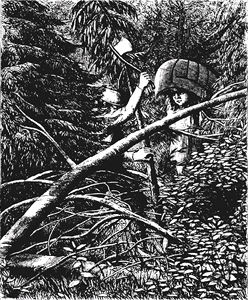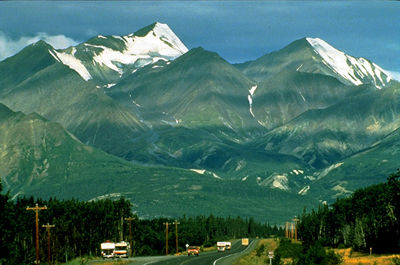The Trans-Canada Highway is a continuous road that allows vehicle travel across Canada. The highway runs through each of Canada’s 10 provinces, from Victoria, British Columbia, to St. John’s, Newfoundland and Labrador. At 7,821 km, it is the fourth-longest highway — and second-longest national highway — in the world.
Background
Outside of cities, roads remained relatively rare in Canada until the 20th century. Travellers mainly used waterways, trails and, beginning in the 19th century, railways.
With the rise of the automobile, demand grew for roads that connected cities and provinces. Motorists, in particular, wanted highways — paved roads that would allow for faster travel. In 1912, the Canadian Highway Association began urging the Canadian government to build a highway system between the provinces. This group of British Columbian car enthusiasts even offered a medal to anyone who could cross Canada entirely by car. British journalist Thomas Wilby completed a cross-country car journey in 1912. However, he used steamship ferries and rail cars to cross Northern Ontario, which did not have connecting roads. This made him ineligible for the medal.
In 1919, the Union government of Prime Minister Robert Borden passed the Canadian Highway Act. Because road construction was a provincial duty, the federal government avoided taking an active role in highway construction. It limited its role to setting road standards and providing a share of funding.
During the Great Depression, the federal government further funded highway construction to stimulate the economy. It gave the provinces over $19 million to build a highway that would allow Canadians to “traverse the Dominion without entering United States territory.” Though the project did not achieve a national network, some roads built with these funds eventually formed part of the Trans-Canada Highway.
Plan and Route
On 10 December 1949, the Liberal government of Prime Minister Louis St-Laurent passed An Act to Encourage and to Assist in the Construction of a Trans-Canada Highway. This law became known as the Trans-Canada Highway Act. Similar to the 1919 act, it set road standards and provided half of the funding for a national highway system. For some sections, the federal government’s share of funding eventually grew to 90 per cent. The remainder of the funding and the work fell to the provinces.
The chosen route began in Victoria, British Columbia, and connected with Vancouver before continuing eastward. The planned highway passed through Calgary, Regina, Winnipeg, Thunder Bay, Ottawa, Montreal, Quebec City, Fredericton, Moncton, Charlottetown, Sydney and St. John’s, Newfoundland. Ferries connected Vancouver Island, Prince Edward Island and Newfoundland to the mainland route.
Challenges and Completion
The Trans-Canada Highway Act set 1956 as the deadline for construction. However, negotiations with the provinces delayed work by years. For example, Quebec did not officially sign on to the project until 1960. Construction challenges also caused delays. Saskatchewan was the first province to complete its section of the highway in 1957.
The highway faced three major construction challenges. The first two hurdles lay between Sault Ste. Marie and Wawa in Ontario, along the shores of Lake Superior. The first challenge was that the area had no existing roads. The region’s muskeg swamps posed the second challenge. Building a highway through these deep swamps required 25 bridges and tonnes of gravel to create a solid road base. The third challenge was building through Rogers Pass in British Columbia. With an average of 8.5 m of snow per year, Rogers Pass received many avalanches. These avalanches threatened to close the highway to traffic for 75 or more days a year. The solution was a unique system of snowsheds (roadway coverings) and controlled avalanches.
The challenge of completing Rogers Pass played a part in Prime Minister John Diefenbaker’s decision to officially open the Trans-Canada Highway there on 3 September 1962. (In protest over the funding agreement, BC’s premier, W.A.C. Bennett, boycotted this event. Bennett held an earlier official opening at the same spot on 30 July 1962. He referred to the road as “BC Highway 1.”)
Despite its official opening, the highway was not physically complete in 1962. One section in Newfoundland took until 1965, and up to half of the length of the highway was not yet paved. It took until 1971 for the highway to be finished to the standards laid out in the Trans-Canada Highway Act in 1949.
Growth of a Network
Since completion of the main route, multiple alternative routes have been added. The largest of these is the Yellowhead Highway. This leg runs north of the original Trans-Canada Highway through Western Canada, from Winnipeg to Haida Gwaii. Other major offshoots include Highway 17 in Ontario and the Confederation Bridge. Highway 17 connects Sudbury and Ottawa through Northern Ontario. Confederation Bridge connects Prince Edward Island to New Brunswick.
The current Trans-Canada Highway totals about 12,800 km of paved roads across 10 provinces. The main route, at 7,821 km, is the world’s fourth-longest highway. Among national highways, it is the second longest in the world, after Australia’s Highway 1.

 Share on Facebook
Share on Facebook Share on X
Share on X Share by Email
Share by Email Share on Google Classroom
Share on Google Classroom







